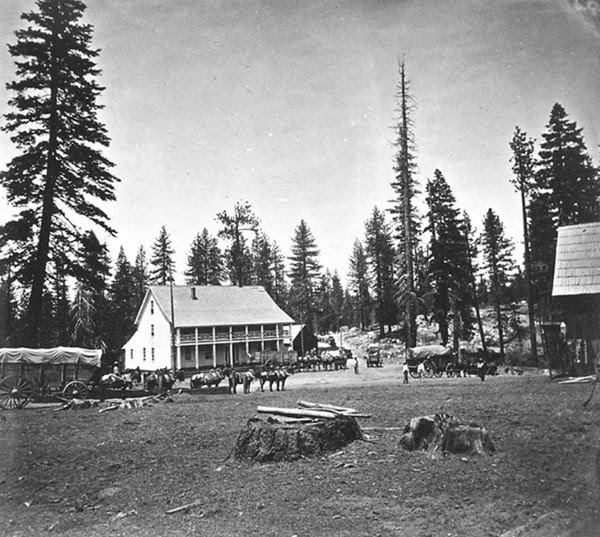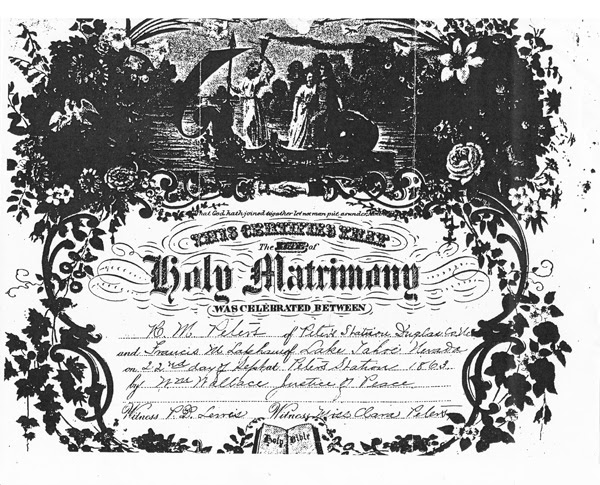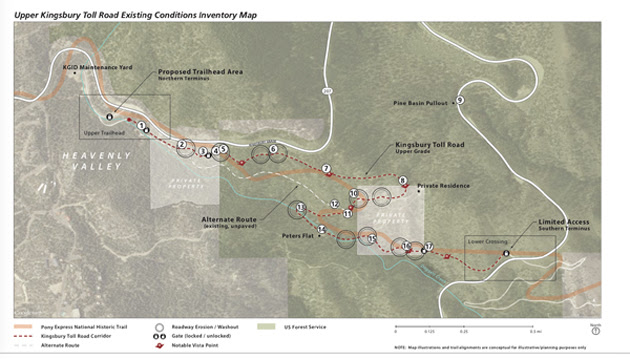Halfway up Kingsbury Grade once stood an early hotel known as Peters Station. If you were a teamster, this was the place to stop!
Situated on a flat spot at a big bend in the trail, Peters Station was a welcome oasis where men and animals alike could eat, drink, and rest from their labors ferrying goods up and down the dusty track.

Not all the teamsters who stopped here would cram into Peters’ three-story hotel to sleep at night, of course. Many were content to simply roll up in their blankets in the bed of their wagons or stretch out on the ground. At one time, the hotel was said to employ five Chinese cooks and five waitresses, and as many as 300 wagons could be found tied up at Peters Flat overnight. And it wasn’t just teamsters who stopped at Peters Station, of course. Travelers headed east or west would have paused here for water. The Pony Express, too, paid quick visits during its brief period of operation over Kingsbury Grade from spring 1860 through October, 1861.
So just who was the “Peters” of Peters Station? Born in Virginia in 1804, Richard Peters had been a mule-skinner himself before morphing into a station owner. Richard, his wife, Elizabeth Elvira (Enlow), and their seven children had crossed the plains in 1850 at the height of the Gold Rush, settling initially in Fremont, Yolo County. Perhaps lured by fresh mining strikes, the Peters family moved on to Grass Valley in 1851.
About 1860 the Peters family moved once again. This time they picked a small spot located about halfway down the fresh Kingsbury Toll Road to set their roots, a site that soon became known as Peters Flat. The ground here was relatively level and timber abundant. Nearby springs afforded them water. The family planted a garden in a meadow close by and raised staples like corn, beans, potatoes, beets and tomatoes for the hotel’s table. Although perched at an elevation of 6,400 feet, their gardening efforts proved a splendid success. The family would later claim that their vegetables ripened two weeks before crops in Carson Valley.
Richard Peters’ timing to launch his new station was auspicious — and probably not coincidental. Kingsbury & McDonald officially opened their new wagon road in August, 1860 (and it actually had been in use for several months earlier). The new toll road quickly become the preferred route for teamsters hauling goods to Genoa or Virginia City, not only shortening the distance but also cutting travel time from Placerville to Carson Valley by a full day.
But the early Kingsbury dirt roadway was steep and difficult to navigate. A pause to rest at the halfway point made splendid sense. Other settlers began to appear about the same time along this downward stretch, too. By 1861, a “grog shop” was in full swing just west of Peters’ Station, while yet another settler had built a house a bit down the canyon.


Young Richard M. Peters, the eldest son of the family, had been born in Missouri in November, 1839. That made him about 21 years old when the family first opened their station, and he soon began to cast his eye around for a wife. Options for a marriage mate must have been slim pickings indeed at the Peters outpost on the side of a mountain. But not far away was Lake Tahoe and the growing settlement at South Lake.
On September 22, 1863, wedding bells were ringing. Richard M. Peters and Miss Frances Marion Lapham, a Tahoe girl, tied the knot right there at the Peters family hotel. Richard was not quite 24 years old at the time; France was a mere 14. Despite her youth, Frances would have been no stranger to the hard work of running a hotel. She was the daughter of “Capt. Billie” (William W.) Lapham, a former hotel proprietor himself at Calaveras Big Trees and, more recently, a hotel and commercial fishing boat operator at South Lake Tahoe. Frances and Richard would go on to have nine children together.

But patriarch Richard Peters did not get to enjoy his new station for long. He died there at Peters Flat on February 19, 1866. It was “the dead of winter,” and the roadway would have been covered in snow. Somehow, his body was ferried up Kingsbury Grade and buried “at Rowland’s Station in Lake Valley” (now known as the Pioneer Cemetery at Al Tahoe). Peters was 61 years old. His wife, Elizabeth, would live on for another 25 years, finally passing away in Ely on December 17, 1891.

After his father passed away, Richard M. and other members of the family continued to run Peters Station for a time. Timber was abundant and, according to family lore, they added logging to supplement their hotel income. In later years a sawmill was said to be operating at Peters Flat. One brief newspaper mention confirms that as late as 1892, two trips a day were still being made from Peters Station to Hobart using horse-drawn teams to haul cedar posts .
Eventually, however, Richard M. sold Peters Station (some say it was bought by Peter Van Sickle), and moved away. Family history says he went on to try his hand at mining in Ward, Nevada (south of Ely) and other sites in Central Nevada. He died on June 6, 1915 in San Francisco, and is buried at Cypress Lawn Cemetery.
The hotel itself is long gone, though as late as the 1980s a few surviving fruit trees still marked the site of Peters Station. Today, the spot where Richard Peters and his family once welcomed hundreds of teamsters is part of the Humboldt-Toiyabe National Forest.

_________________
Family information for this story comes from materials kindly contributed by Dr. Perry Close (a Peters family descendant) to the Van Sickle Research Room at Douglas County Historical Society & Museum about 1992. Many to DCHS for the marriage certificate and first map shown above. Special thanks are also due to historian Sue Silver for her wonderful input, research and encouragement for this article, and especially for sharing the 1861 Ives map.
